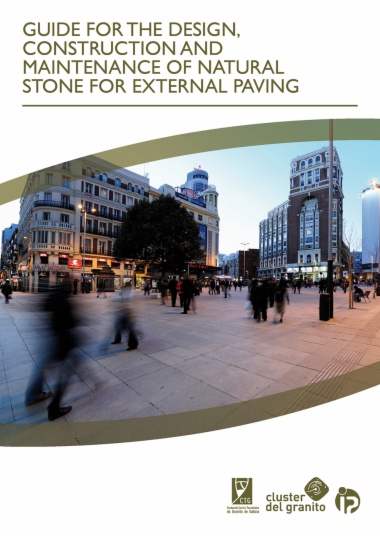The use of stone for pavement construction has been practiced by humans since historical times. This book, focusing on the granite, is a comprehensive technical guide to learn about the qualities and wide range of varieties and design that offers natural stone for the design and construction of deck flooring. Also describes major damages and types of exterior flooring repairs and instructions make it easy for your optimum maintenance, cleaning and conservation.
- Index
- Presentation
- Introduction
- 1. Stone for pavement construction
- 1.1. Brief historic overview
- 1.2. Natural stone designation
- 1.3. Varieties of natural stone
- 1.4. Surface finishes
- 1.5. Advantages of stone for pavement construction
- 2. Pavement Units
- 2.1. Slabs
- 2.2. Setts
- 2.3. Kerbs
- 3. Natural Stone Controls
- 3.1. CE marking
- 3.2. Control requirements
- 3.2.1. Size requirements
- 3.2.2. Flexural strength
- 3.2.3. Compressive strength
- 3.2.4. Coefficient of water absorption at atmospheric pressure
- 3.2.5. Coefficient of water absorption by capillarity
- 3.2.6. Abrasion resistance
- 3.2.7. Skid resistance
- 3.2.8. Frost resistance
- 3.2.9. Impact resistance
- 3.2.10. Petrographic denomination
- 3.2.11. Fire performance
- 3.2.12. Soluble salt crystallisation
- 3.2.13. Appearance
- 3.2.14. Resistance to ageing by thermal shock
- 3.2.15. Sensitivity to changes in appearance produced by the thermal cycles
- 4. Road and sidewalk projects
- 4.1. Section type
- 4.2. The subgrade
- 4.3. The granular subbase
- 4.4. The structural base
- 4.5. The support layer
- 4.6. Other design tools
- 4.7. Choosing the stone
- 4.8. Grouting
- 4.8.1. Size and layout
- 4.8.2. Grout materials
- 4.9. Drainage
- 4.9.1. Surface slope
- 4.9.2. Drainage pipe slope
- 4.9.3. Cover and gratings of channels, manholes and drains
- 5. Calculation of paving system
- 5.1. Slabs
- 5.1.1. Calculating the thickness of the slabs
- 5.1.2. The adherence and regularization layer
- 5.1.3. Thickness of the structural base layer
- 5.2 Sett pavements
- 5.2.1. Thickness calculation
- 5.3. Calculating kerbs and curbs
- 6. Pavement implementation
- 6.1 Storage at work site
- 6.2. Layout and signaling
- 6.3. Execution
- 6.3.1. The grade surface
- 6.3.2. The granular subbase
- 6.3.3. The structural base
- 6.3.4. The supporting and adherence layer
- 6.3.5. Placing the slabs
- 6.3.6. Laying of setts
- 6.3.7. Laying of kerbs
- 6.4. Construction designs
- 7. Quality control
- 7.1. Norms
- 7.1.1. Spanish technical Building Code (CTE)
- 7.1.2. Products subject to the Construction Products Directive (CPD)
- 7.2. Controls prior to delivery of stone
- 7.3. Controls at work site upon the reception of the stone
- 7.4. Pavement layout controls
- 8. Damages and repair
- 8.1. Direct causes
- 8.1.1. Physical
- 8.1.2. Mechanical
- 8.1.3. Chemical
- 9. Maintenance, cleaning and conservation
- 9.1. Maintenance and storage
- 9.2. Cleaning
- 10. Drawing up budgets
- BIBLIOGRAPHICAL REFERENCES

